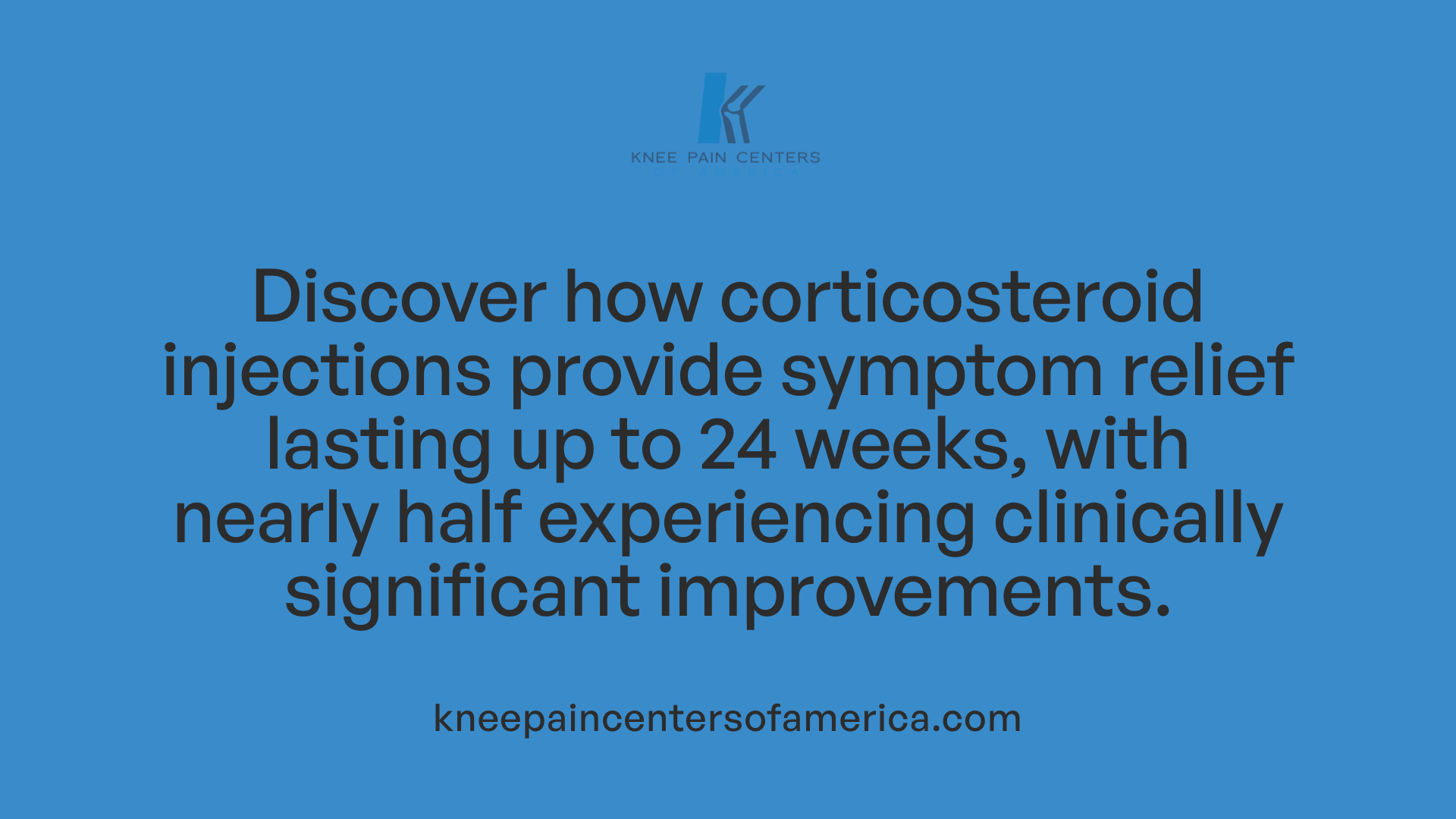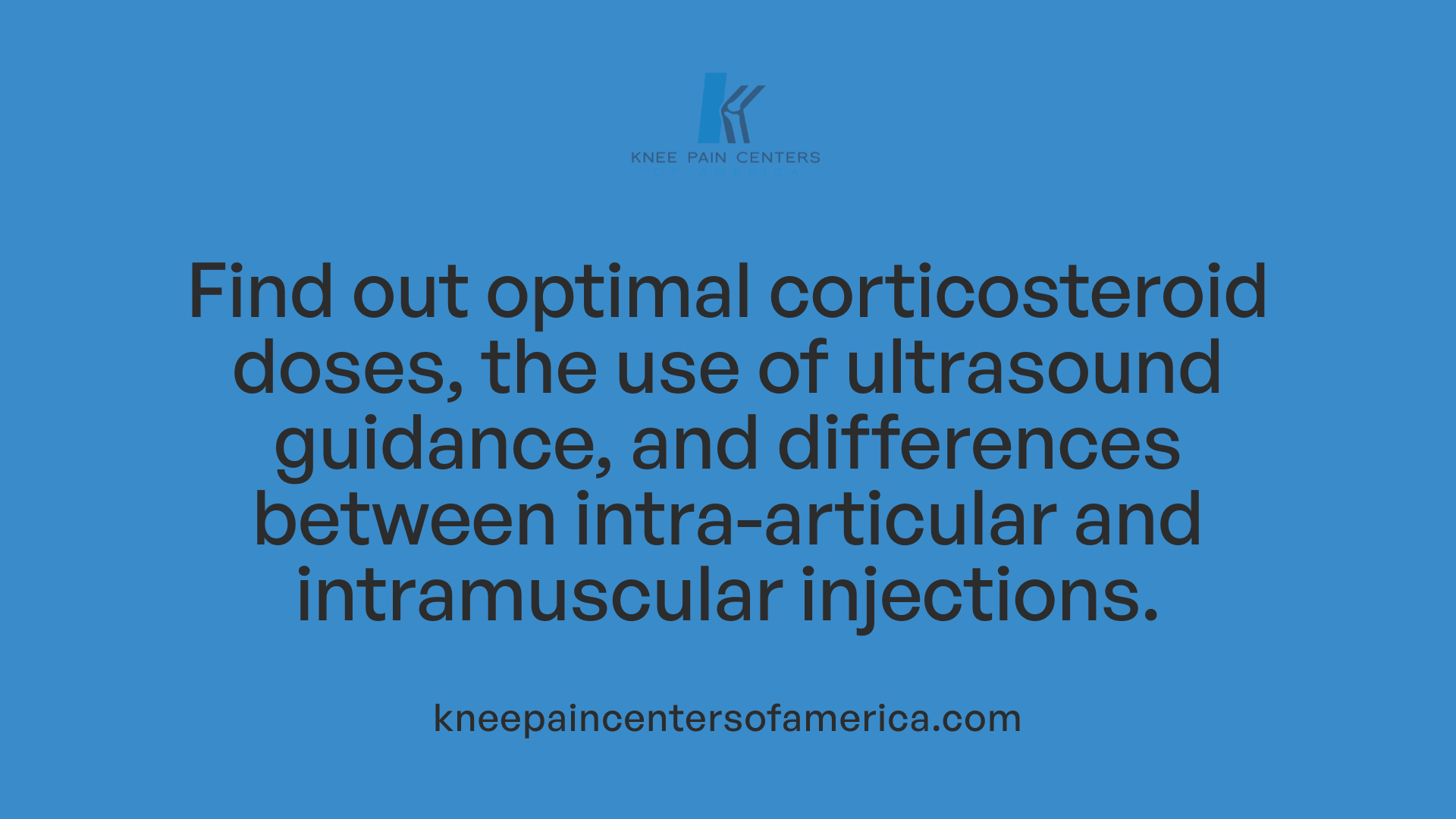Understanding Corticosteroid Injections for Knee Health
Corticosteroid injections are a common treatment approach aimed at reducing inflammation and alleviating pain in acute knee injuries and knee osteoarthritis. As knee pain affects millions globally, understanding the efficacy, safety, and role of corticosteroid injections within the broader spectrum of knee therapies is critical for patients and healthcare providers.
Clinical Evidence Supporting Corticosteroid Injections for Knee Osteoarthritis

Study design for corticosteroid injection efficacy
A rigorous double-blind, randomized controlled trial involving 31 participants with knee osteoarthritis tested the effects of corticosteroid plus lidocaine injections against lidocaine-only injections. This design ensured unbiased results reflecting real treatment outcomes.
Improvements in KOOS scores
The primary outcome was the change in the Knee Injury and Osteoarthritis Outcome Score (KOOS). Participants receiving corticosteroids showed a mean KOOS increase of 9.4 points, while the control group experienced a 1.3-point decline over 12 weeks (P=0.003). Nearly 47% of those treated with corticosteroids met or exceeded the minimal clinically important difference of 16 units, compared to only 6% in the control group.
Clinical significance of symptom relief
These findings reflect significant short-term symptom relief, including reductions in pain and improvements in daily activities and quality of life. Secondary measures corroborated these benefits. No serious adverse events were reported, highlighting the treatment's safety profile. This evidence positions corticosteroid injections as an effective approach for managing knee osteoarthritis pain temporarily, aligning with current clinical guidelines recommending their use for symptom control.
What are the most effective medical treatments for knee pain and osteoarthritis?
Corticosteroid injections have been shown in double-blind randomized controlled trials to provide clinically meaningful short-term improvements in knee osteoarthritis symptoms, including significant reductions in pain and enhancements in function and quality of life.
Magnitude and Duration of Benefits from Corticosteroid Injections

Short-term symptom relief up to 12 weeks
Corticosteroid injections offer meaningful relief to patients suffering from knee osteoarthritis (KOA), with clinically significant reductions in pain and improvements in function and quality of life observed up to 12 weeks post-injection. In a randomized controlled trial involving 31 participants, those receiving corticosteroids exhibited a mean increase of 9.4 points on the Knee Injury and Osteoarthritis Outcome Score (KOOS), whereas the lidocaine-only control group showed a slight decrease. These results demonstrate the injections' capacity to alleviate symptoms effectively in the short term.
Percentage of patients achieving minimal clinically important difference
Approximately 47% of patients treated with corticosteroid injections attained a change in KOOS that met or exceeded the minimal clinically important difference (16 units), compared to only 6% in the control group. This indicates nearly half of the patients experienced a substantial improvement in symptoms that likely translated to noticeable functional benefits and enhanced quality of life within the first three months.
Meta-analysis findings on longer-term outcomes
Beyond the initial 12 weeks, meta-analyses have shown corticosteroid injections continue to provide benefits at 16 to 24 weeks, with a pooled relative risk for symptom improvement of 2.09. The number needed to treat is approximately 4.4, meaning that for every four patients treated, one experiences significant symptom relief over this period. Higher corticosteroid doses, equivalent to 50 mg of prednisone, tend to be required to observe these extended benefits. Importantly, repeated injections over two years have not demonstrated evidence of accelerating joint damage or osteoarthritis progression, supporting the relative safety of this treatment within recommended dosing limits.
How do non-surgical treatments help manage osteoarthritis symptoms?
Intra-articular corticosteroid injections effectively provide short-term relief of pain and functional limitations in knee osteoarthritis, with almost half of the treated patients experiencing meaningful clinical improvement within 12 weeks. While these benefits may diminish over time, meta-analytic data confirm symptom improvements can persist for up to 24 weeks. This positions corticosteroid injections as valuable non-surgical options for managing osteoarthritis symptoms, complementing other treatments like physical therapy and lifestyle modifications.
Safety Profile and Adverse Events Associated with Corticosteroid Injections

Frequency and Nature of Adverse Effects
Corticosteroid injections for knee osteoarthritis are generally well tolerated, with minimal serious adverse events reported. Common side effects include transient pain, swelling, bruising at the injection site, allergic reactions, and occasional mild systemic symptoms like hot flush and headache. Notably, only one patient fainted during injection across studies, highlighting a low incidence of severe complications. One participant required a rescue corticosteroid injection at 10 weeks without further complications.
Concerns about Cartilage Damage and Disease Progression
There has been concern that repeated corticosteroid injections could accelerate joint damage or promote osteoarthritis progression. However, current evidence does not support these fears. Studies observing patients over two years found no association between repeated injections and cartilage deterioration or joint destruction. Changes in cartilage volumes are more likely related to the natural disease course rather than the steroids themselves. Nonetheless, excessive or frequent use, particularly doses above 40 mg of triamcinolone or methylprednisolone, might increase risks such as osteonecrosis and rapid disease progression.
Guidelines for Injection Frequency Limits
To minimize potential risks, clinical guidelines recommend limiting corticosteroid injections to no more than three or four times per year per joint. Dosing at the minimally effective level, adhering to recommended intervals between injections, and using image guidance can optimize safety. Additionally, injections should be carefully timed, especially in patients scheduled for joint replacement surgery, as administration within 2 to 4 weeks before surgery is linked with increased risk of postoperative joint infection. Monitoring of blood glucose levels in diabetic patients and avoiding high cumulative doses over a year (exceeding 200 mg triamcinolone equivalents) are advisable practices.
Together, these safety considerations emphasize cautious and judicious use of corticosteroid injections, balancing their short-term symptomatic benefits against rare but important risks.
Dose Considerations and Injection Techniques

Optimal corticosteroid dosing for knee injections
The effectiveness of corticosteroid injections in knee osteoarthritis depends significantly on the dosing used. Studies indicate that a dose of 40 mg of triamcinolone is typically effective for knee injections. Increasing the dose beyond 40 mg does not necessarily enhance symptom relief, and doses equivalent to or exceeding 50 mg prednisone might be required to maintain benefits at 16 to 24 weeks. It is essential to use the minimal effective dose to balance symptom control while limiting risks such as cartilage damage or osteonecrosis, which are associated with higher or frequent dosing. Guidelines recommend avoiding cumulative doses exceeding 200 mg triamcinolone equivalents annually and no more than three to four injections per year to minimize adverse effects.
Role of ultrasound guidance
Ultrasound guidance is increasingly utilized during knee corticosteroid injections to improve the accuracy of medication delivery. It helps in visualizing the joint space, ensuring precise placement of the corticosteroid, and reducing procedural pain for the patient. Although long-term outcomes like symptom relief might not differ significantly compared to landmark-guided injections, the enhanced accuracy and patient comfort support the routine use of ultrasound. Moreover, image guidance can contribute to optimizing safety, especially when injections are timed around procedures such as joint replacement surgery.
Comparison of intra-articular vs. intramuscular injections
Both intra-articular (IA) and intramuscular (IM) corticosteroid injections have demonstrated meaningful symptom relief in knee osteoarthritis over a 24-week period. Initial pain reduction at four weeks favors IA injections slightly; however, noninferiority of IM injections is established at 8 and 24 weeks. Both methods improve joint symptoms, function, and quality of life, with IM injections showing a slightly better adverse event profile, including fewer headaches and hot flushes. This evidence supports flexibility in choosing injection routes, considering patient preference, safety, and access. Shared decision-making between clinicians and patients is encouraged to select the optimal approach.
| Injection Type | Typical Dose | Advantages | Considerations |
|---|---|---|---|
| Intra-articular (IA) | 40 mg triamcinolone | Direct joint delivery, quicker pain relief | Requires ultrasound guidance for best accuracy; risk of joint infection if timed close to surgery |
| Intramuscular (IM) | Equivalent corticosteroid dose | Easier administration, fewer adverse events | Slightly slower onset; noninferior in long-term pain relief |
| Ultrasound guidance | N/A | Improved injection accuracy, reduced pain | Requires equipment and training |
| Dose management | ≤ 40 mg triamcinolone recommended; max 3-4/year | Balances efficacy and safety | Higher doses increase risk of cartilage damage and osteonecrosis |
Comparative Effectiveness: Corticosteroid Injections Versus Physical Therapy
Physical therapy outcomes at 1 year
Physical therapy for knee osteoarthritis has demonstrated superior long-term benefits compared to corticosteroid injections. In a study involving 156 patients, those undergoing physical therapy showed a greater reduction in the Western Ontario and McMaster Universities Osteoarthritis Index (WOMAC) score by 18.8 points at one year. This improvement reflects less pain and better physical function compared to individuals who received intra-articular corticosteroid injections.
Sustained functional improvements
Unlike corticosteroid injections that primarily provide short-term relief lasting up to 12 weeks, the benefits of physical therapy tend to be sustained over time. Secondary outcomes such as functional task tests (Timed Up and Go, Alternate Step Test) and global assessments also favored physical therapy at the one-year mark. This suggests that physical therapy contributes not only to symptom management but improved overall joint function in the longer term.
Safety and patient preferences
Both treatment modalities are generally safe, with minimal adverse events reported. Corticosteroid injections carry some risk if administered frequently or in high doses, whereas physical therapy avoids these concerns. Patient preferences and clinical contexts should guide shared decision-making, considering that corticosteroid injections offer quick, though temporary, symptom relief while physical therapy supports lasting functional gains.
What are the most effective medical treatments for knee pain and osteoarthritis?
While corticosteroid injections provide effective short-term symptom relief, physical therapy has been shown to yield greater pain reduction and improved physical function at one year. Optimal management may involve combined or sequential approaches that leverage the immediate benefits of injections alongside the lasting improvements from physical therapy.
Role of Corticosteroids in Acute Knee Injury Management
Use of injections for acute trauma and inflammation
Corticosteroid injections are commonly employed to manage inflammation and pain in acute knee injuries. By directly introducing anti-inflammatory medication into the joint, these injections help reduce swelling and discomfort associated with trauma. This intervention plays a vital role in alleviating pain that often limits patients' mobility.
Effect on pain and stiffness
The administration of corticosteroid injections provides meaningful short-term relief from the pain and stiffness characteristic of knee injuries and osteoarthritis. Studies show improvements in pain intensity, joint function, and patient quality of life lasting up to several weeks, which supports better movement and rehabilitation potential during the critical early recovery phase.
Clinical guidelines and best practices
Clinical recommendations support the use of intra-articular corticosteroid injections as part of a multimodal treatment approach for symptom management in osteoarthritis and acute knee inflammation. To optimize safety, clinicians typically limit use to no more than three to four injections annually and consider image guidance techniques to enhance injection accuracy and reduce procedural discomfort. Monitoring for adverse events such as cartilage damage or infection is advised, especially when corticosteroid therapy precedes potential surgeries.
How do non-surgical treatments help manage osteoarthritis symptoms?
Corticosteroid injections administered during acute knee injuries can reduce inflammation and provide short-term relief from pain and stiffness, facilitating improved mobility and function during recovery phases.
Emerging Injection Therapies for Knee Osteoarthritis
Platelet-rich plasma (PRP) and hyaluronic acid injections
Platelet-rich plasma (PRP) injections use components of the patient's own blood that are rich in growth factors to stimulate healing and tissue regeneration in the knee joint. They have shown promise in relieving symptoms of mild to moderate osteoarthritis and in some cases provide longer-lasting pain relief compared to traditional therapies.
Hyaluronic acid injections, often called viscosupplementation, add a lubricant to the joint to improve mobility and reduce pain by supplementing the natural joint fluid. Effects typically last several months and help improve joint function in osteoarthritis patients.
Prolotherapy and experimental treatments
Prolotherapy involves injecting a sugar water solution aimed at stimulating the body’s healing processes to reduce pain and improve joint function. However, its effectiveness remains less established, and it is not regulated by the FDA.
Experimental injections such as autologous conditioned serum and stem cell therapies are being investigated for their ability to reduce inflammation, support cartilage repair, and potentially slow osteoarthritis progression. These treatments are still in research phases and lack formal regulatory approval.
Current evidence and regulatory status
While these emerging therapies offer exciting possibilities to target tissue healing rather than only symptom relief, current evidence varies widely. PRP and hyaluronic acid have some supporting data and clinical use, whereas prolotherapy and stem cell treatments require more rigorous trials to confirm their safety and effectiveness.
Stem cell therapy, in particular, has uncertain benefits and has not yet been approved by regulatory bodies for routine treatment of knee osteoarthritis. Patients and clinicians should carefully consider these factors and engage in shared decision-making when exploring emerging injection options.
| Therapy Type | Mechanism | Evidence Status | Regulatory Approval |
|---|---|---|---|
| Platelet-rich plasma | Growth factor stimulation | Moderate with some clinical support | Limited but used in practice |
| Hyaluronic acid | Joint lubrication | Well-studied with symptom relief | Widely approved |
| Prolotherapy | Healing stimulation (sugar solution) | Limited and less evidence | Not FDA-regulated |
| Stem cell therapy | Cartilage repair and regeneration | Experimental, uncertain benefits | Not FDA-approved |
Understanding the Risks of Frequent Corticosteroid Use
Potential joint damage with excessive frequency
While corticosteroid injections provide noticeable short-term relief for knee osteoarthritis, their frequent use poses risks to joint health. Evidence indicates that repeated intra-articular corticosteroid injections, especially beyond three or four times per year, can contribute to cartilage volume loss. Such damage may escalate joint degeneration over time, contradicting the intended therapeutic benefits.
Osteonecrosis and accelerated osteoarthritis risks
Excessive corticosteroid exposure increases the risk of osteonecrosis—a condition where bone tissue dies due to insufficient blood supply. Moreover, intensive corticosteroid dosing, particularly doses exceeding 40 mg of triamcinolone or methylprednisolone, have been linked to rapid progression of osteoarthritis. This highlights the delicate balance clinicians must maintain between symptom relief and avoiding long-term joint deterioration.
Monitoring recommendations in clinical practice
To safeguard patients, clinicians are advised to monitor cumulative corticosteroid doses carefully and limit injections to the minimally effective dose. Special attention should be given to diabetic patients, as corticosteroids can elevate blood glucose levels. Additionally, injections should be timed cautiously, especially if joint replacement surgery is anticipated, to reduce postoperative infection risk. These precautions help optimize benefits while minimizing adverse effects associated with corticosteroid therapies in knee osteoarthritis management.
Clinical Guidelines Surrounding Corticosteroid Injections
Recommended Usage Thresholds
Clinical guidelines advise that corticosteroid injections for knee osteoarthritis should not be administered more than three to four times annually. This limitation aims to reduce the risk of joint damage, which may include cartilage volume loss and osteonecrosis, particularly when high doses exceeding 40 mg of triamcinolone or methylprednisolone are used. Maintaining these usage thresholds ensures patient safety while optimizing pain relief.
Indications for Short-Term Symptom Relief
Corticosteroid injections are primarily indicated for providing short-term symptom relief in patients with knee osteoarthritis. These injections typically offer clinically meaningful pain reduction, improved joint function, and enhanced quality of life for up to 12 weeks, with some meta-analyses showing benefits extending to 16-24 weeks. They are particularly recommended in clinical scenarios requiring rapid control of inflammation and pain, such as during flare-ups or before engaging in physical therapy.
Strategies to Minimize Adverse Effects
To minimize complications, clinicians should use image guidance such as ultrasound or X-ray to increase injection accuracy and reduce procedural discomfort. Dosing should be kept at minimally effective levels, for example, 40 mg triamcinolone for knee injections, to balance effectiveness and safety. It is important to avoid corticosteroid injections within three months prior to planned joint replacement surgery due to increased risks of postoperative infection, especially when performed within 2-4 weeks. Additionally, blood glucose monitoring and dose limits should be carefully considered in diabetic patients to mitigate systemic side effects like adrenal suppression and hyperglycemia.
The Influence of Injection Timing on Surgical Outcomes
Risk of postoperative joint infection after injection
Intra-articular corticosteroid injections can increase the risk of postoperative joint infection if administered too close to joint replacement surgery. Studies highlight the heightened infection risk particularly when injections occur within 2 to 4 weeks prior to surgery, which can lead to serious complications.
Time intervals recommended before joint replacement surgery
To minimize infection risk, guidelines recommend avoiding corticosteroid injections within 3 months before joint replacement surgery. This precaution is crucial to allow sufficient clearance of the steroid and decrease potential immunosuppressive effects around the surgical site.
Clinical decision-making considerations
Clinicians must carefully balance the timing of corticosteroid injections with planned joint surgeries. When injections are necessary for symptom relief, they should be scheduled well in advance of any surgical procedure.
Additionally, using minimally effective doses and image guidance can optimize safety. The timing of injections is a key aspect of shared decision-making, ensuring patients understand the potential risks and benefits related to their surgical outcomes.
Patient Selection and Shared Decision-Making in Injection Therapy
Patient factors affecting treatment choices
Choosing the appropriate injection therapy for knee osteoarthritis largely depends on individual patient factors such as symptom severity, presence of knee effusion, comorbid conditions (e.g., diabetes), and previous treatment responses. Age, activity level, and pain intensity also influence the decision between corticosteroid injections, physical therapy, or alternative injections like platelet-rich plasma or hyaluronic acid.
Benefits and risks discussion
Shared decision-making plays a vital role in selecting corticosteroid injections. Patients should be informed of the short-term benefits like significant pain relief and improved function typically lasting up to 12 weeks, supported by clinical studies showing meaningful KOOS improvements. However, risks such as temporary increased blood glucose (especially in diabetics), potential cartilage loss with frequent injections, and the possibility of injection-site adverse events warrant consideration. Moreover, treatment frequency should be limited to no more than three or four times per year to minimize joint damage risks.
Role of imaging guidance and symptom severity
Utilizing ultrasound or X-ray guidance during injections enhances accuracy and reduces procedural discomfort, thus optimizing outcomes. Imaging can be particularly useful in knees with persistent effusion, where combining corticosteroid injections with joint lavage may improve response. Symptom severity assessment ensures that injections are appropriately timed and dosed, with minimal effective corticosteroid levels reducing safety concerns. In cases where symptoms are less severe or patients prefer non-invasive approaches, physical therapy remains a highly effective alternative with sustained benefits at one year.
In summary, selecting corticosteroid injections involves shared decision-making where clinicians and patients weigh symptom severity, potential benefits, risks, and alternative treatments including physical therapy and other injection options.
Knee Injection Procedures: Techniques and Patient Experience
Use of Ultrasound or X-ray Guidance
Knee injections are commonly performed in a doctor's office, with ultrasound or X-ray guidance used to enhance the accuracy of delivering medication directly into the knee joint or surrounding tissues. Ultrasound guidance allows real-time visualization of needle placement, which not only improves precision but also tends to reduce procedural pain. While long-term outcomes may not significantly differ from landmark-guided injections, using imaging techniques can contribute to a more comfortable experience for the patient.
Common Injection Sites and Medications
The most frequent site for injections is the intra-articular space of the knee, where medications can directly address joint inflammation and pain. Common medications include corticosteroids such as triamcinolone or methylprednisolone, administered in doses typically ranging from 20 mg to 40 mg depending on the injection site and patient need. Other injectable treatments used in knee osteoarthritis comprise platelet-rich plasma (PRP), hyaluronic acid (viscosupplementation), and experimental therapies like stem cell injections.
Patient Comfort and Procedural Pain Management
Minimizing patient discomfort during knee injections involves careful needle placement often aided by ultrasound guidance and use of local anesthetics like lidocaine. Some patients may experience mild adverse effects such as pain, swelling, or bruising at the injection site, but serious complications are rare. Ensuring adequate patient preparation and post-procedure monitoring contributes to a favorable patient experience during and after knee injection procedures.
Comparing Intra-Articular and Intramuscular Glucocorticoid Injections

How Effective Are Symptom Relief Outcomes for Intra-Articular vs Intramuscular Glucocorticoid Injections?
Both intra-articular (IA) and intramuscular (IM) glucocorticoid injections provide meaningful symptom relief for knee osteoarthritis over a 24-week period. Studies measured pain reduction primarily at 4, 8, and 24 weeks using the Knee Injury and Osteoarthritis Outcome Score (KOOS) pain subscale.
At 4 weeks, IA injections showed somewhat greater pain reduction compared to IM injections, but the difference did not confirm IM injection noninferiority. However, by 8 and 24 weeks, IM injections demonstrated noninferiority, with minimal mean differences (0.7 and 1.6 points) that did not breach the preset noninferiority margin. Both injection types led to significant improvements in joint symptoms, stiffness, function, and quality of life.
What Are the Safety Profiles and Adverse Event Rates of IA and IM Injections?
Both injection methods are generally safe with mostly nonserious adverse events reported. The most common side effects included hot flushes and headaches. Interestingly, the IM injection group experienced slightly fewer adverse events than the IA group. No serious complications such as infections or structural damage were associated with either method in these studies.
What Are the Clinical Implications of Choosing Between IA and IM Glucocorticoid Injections?
Given the comparable effectiveness of symptom relief by 8 weeks and favorable safety profiles, both IA and IM glucocorticoid injections represent viable options for managing knee osteoarthritis pain. Treatment choice can thus be personalized based on patient preference, clinical setting, and risk considerations.
Shared decision-making is encouraged for clinicians and patients, weighing the short-term benefit timeline of IA injections against the convenience and lower adverse event incidence of IM injections. Further research will continue to refine their roles, but currently both injections support effective symptom management strategies in primary care and specialty settings.
Potential Benefits of Combining Corticosteroid Injections with Joint Lavage
Use in Knees with Persistent Effusion
Knee osteoarthritis often presents with persistent effusion, which is swelling caused by excess fluid accumulation within the joint. Combining corticosteroid injections with joint lavage—a procedure that irrigates the knee joint—has been suggested as a promising approach in managing these cases. Lavage can help remove inflammatory mediators and debris from the joint, potentially enhancing the therapeutic effects of corticosteroids.
Enhanced Symptom Relief
Clinical observations indicate that when corticosteroid injections are combined with joint lavage, patients with persistent knee effusion may experience greater symptom relief than with corticosteroids alone. This combination may lead to faster reduction in pain and improvements in joint function by addressing both inflammation and excess fluid that contributes to discomfort and limited mobility.
Current Evidence and Need for Further Research
While initial findings are encouraging, the current body of evidence supporting the use of corticosteroid injections combined with joint lavage remains limited. More rigorous, large-scale clinical trials are necessary to determine the optimal protocols, confirm efficacy, and understand long-term outcomes. Future research should also clarify which patient populations benefit most from this combined approach to better guide clinical decision-making.
Physical Therapy: A Complement or Alternative to Corticosteroid Injections
How do non-surgical treatments help manage osteoarthritis symptoms?
Physical therapy stands out as a highly effective non-surgical approach for managing knee osteoarthritis symptoms over the long term. Unlike corticosteroid injections, which often provide short-term relief limited to a few weeks, physical therapy yields sustained improvements in both pain and physical function, with benefits lasting at least one year.
Clinical trials comparing physical therapy to intra-articular glucocorticoid injections demonstrate that patients undergoing physical therapy experience significantly greater reductions in pain as measured by the Western Ontario and McMaster Universities Osteoarthritis Index (WOMAC). Functional task assessments, such as the Timed Up and Go test and the Alternate Step Test, also improve more in the physical therapy group, illustrating enhanced mobility and physical capability.
These functional gains translate into a more favorable global assessment of improvement by patients receiving physical therapy. Notably, the safety profiles of both physical therapy and corticosteroid injections are favorable with minimal adverse events reported. Additionally, healthcare costs appear similar between the two approaches over a one-year period, further supporting physical therapy as a cost-conscious choice.
Integration into osteoarthritis management plans
Given the sustained benefits of physical therapy and the temporary relief from corticosteroid injections, clinicians should consider integrating physical therapy either before or alongside injection therapies. This approach maximizes both short-term symptom control and long-term functional improvements.
Physical therapy's role complements injection treatments by addressing muscle strength, joint stability, and movement patterns, which corticosteroids do not influence. Thus, a combined strategy provides a comprehensive management plan that addresses both symptoms and functional deficits in knee osteoarthritis.
Cost Considerations of Corticosteroid Injections and Physical Therapy
How do healthcare expenditures compare between corticosteroid injections and physical therapy?
Healthcare costs for patients receiving corticosteroid injections and those undergoing physical therapy for knee osteoarthritis are reported to be similar over a one-year period. Although direct expenditure amounts are not detailed, studies note that neither treatment leads to markedly higher overall healthcare spending within this timeframe.
What are the cost-effectiveness aspects of these treatments?
Formal cost-effectiveness analyses have not been extensively performed comparing corticosteroid injections and physical therapy. However, physical therapy tends to offer more sustained functional benefits, which may translate into better long-term value despite similar short-term costs. Corticosteroid injections provide quicker symptom relief but typically require repeated treatments, which could add to cumulative costs and potential risks.
What are the implications for patients and health systems?
For patients, the similarity in healthcare expenditures means decisions on treatment may hinge more on clinical outcomes and personal preferences than cost. Health systems benefit from offering both options as viable and potentially complementary strategies. Shared decision-making processes can incorporate cost considerations alongside effectiveness and patient priorities to optimize care and resource allocation.
Addressing Patient Safety: Monitoring Blood Glucose and Dose Limits
How do corticosteroid injections impact diabetic patients?
Corticosteroid injections can temporarily raise blood glucose levels, which is particularly important for diabetic patients undergoing treatment for knee osteoarthritis. Monitoring blood glucose closely during the weeks following an injection is essential to avoid hyperglycemia-related complications.
What are the recommended annual dose limits for corticosteroid injections?
To reduce risks such as osteonecrosis, cartilage damage, and rapid osteoarthritis progression, clinicians should avoid exceeding 200 mg of triamcinolone equivalents annually. Additionally, doses higher than 40 mg per injection should be used cautiously.
What strategies help minimize systemic effects and enhance safety?
Minimizing systemic exposure involves:
- Using the lowest effective corticosteroid dose
- Employing image guidance (e.g., ultrasound) to improve injection accuracy and reduce required dose
- Timing injections appropriately, especially limiting use within 3 months before joint replacement surgery to decrease infection risk
- Monitoring diabetic patients' blood glucose closely after injections
These measures collectively optimize patient safety while maintaining the symptomatic benefits of intra-articular corticosteroid therapy for knee osteoarthritis.
Knee Joint Protection: Understanding Cartilage Volume and Injection Impact
Is There Evidence Linking Corticosteroid Injections to Cartilage Volume Loss in Knee Osteoarthritis?
Some studies have observed cartilage volume loss in knees receiving repeated corticosteroid injections. This association mainly appears when injections are frequent or exceed optimal dosage levels. However, evidence suggests that cartilage deterioration is more strongly linked to the natural progression of osteoarthritis rather than corticosteroid use itself.
How Does Osteoarthritis Disease Progression Affect Joint Health Compared to Injection Impact?
Osteoarthritis inherently causes cartilage degradation over time, leading to joint space narrowing and functional decline. The changes seen in cartilage volume in patients receiving injections may largely reflect this underlying disease process rather than being directly caused by corticosteroids. Clinical data do not support corticosteroid injections accelerating disease progression or inducing joint damage when used appropriately.
How Can Clinicians Balance Treatment Benefits of Corticosteroid Injections with Preservation of Joint Health?
Corticosteroid injections effectively reduce pain and improve function temporarily, offering meaningful symptom relief, especially in the short term. To minimize risks associated with joint health:
- Limit injections to three or four times per year
- Employ the lowest effective corticosteroid dose
- Use image guidance to enhance accuracy
- Avoid injections close to planned joint replacement surgery
This balanced approach ensures patients gain symptom benefits without compromising cartilage integrity or increasing adverse effects. Ongoing research aims to clarify long-term joint outcomes and optimize treatment protocols.
Different Corticosteroid Preparations in Knee Injections
Comparative effectiveness of corticosteroid formulations
Clinical evidence indicates there is little clear advantage of one corticosteroid preparation over another when used for intra-articular knee injections. Both triamcinolone and methylprednisolone are commonly employed, with comparable effectiveness in symptom relief for knee osteoarthritis. This suggests that the choice of preparation is often guided by availability, practitioner preference, or patient-specific factors rather than proven superiority.
Recommendations for preparation choice
Guidelines recommend selecting corticosteroid types based on dosing needs and safety profiles rather than efficacy differences. The safety of intra-articular corticosteroid injections can be optimized by using minimally effective doses, applying image guidance for precise delivery, and timing injections thoughtfully, especially when joint replacement surgery is planned to reduce infection risk. Monitoring cumulative doses and patient factors, such as diabetes, is also important for reducing adverse effects.
Dose equivalencies for triamcinolone and methylprednisolone
Typical dosing for knee intra-articular corticosteroid injections often involves 40 mg of either triamcinolone or methylprednisolone. Studies show that 40 mg of triamcinolone provides similar symptom relief to higher doses such as 80 mg, indicating dose sparing is possible. For hip injections, 40 mg is the common dose as well. Dose equivalences facilitate tailoring treatment regimens to balance efficacy with safety, especially avoiding excess annual doses which could lead to joint damage or other side effects.
| Corticosteroid Type | Common Dose for Knee Injection | Notes on Effectiveness and Safety |
|---|---|---|
| Triamcinolone | 40 mg | Effective at 40 mg; 20 mg less effective for shoulder but 40 mg suffices for knee |
| Methylprednisolone | 40 mg | Equally effective and commonly used; choice dependent on availability |
This balanced approach to corticosteroid preparation selection helps maximize symptom relief and minimize risks associated with repeated or high-dose injections in knee osteoarthritis management.
Managing Acute Knee Injury Pain: Role of Corticosteroids Compared to Other Options
How long does corticosteroid injection relief last for acute knee pain?
Corticosteroid injections in the knee provide substantial pain relief and symptom improvement that typically last from a few weeks up to 12 weeks. Meta-analyses observe benefits extending to about 16-24 weeks, albeit with higher doses. Short-term effects are most prominent in the first two weeks post-injection, with nearly half of patients experiencing clinically meaningful improvement in pain and function during this period.
How do corticosteroids compare with other injections and treatments?
Corticosteroids reduce inflammation rapidly, making them effective for short-term symptom relief compared to options like hyaluronic acid or platelet-rich plasma (PRP), which may offer longer-lasting effects but with slower onset. Unlike corticosteroids, PRP injections leverage growth factors to stimulate healing and may provide lasting pain relief in mild to moderate osteoarthritis. Physical therapy, while slower acting, results in better sustained pain reduction and functional improvements at 1 year compared to corticosteroid injections.
| Treatment Type | Duration of Effect | Mechanism | Notes |
|---|---|---|---|
| Corticosteroid Injections | Weeks to ~3 months | Anti-inflammatory | Best for short-term flare relief |
| Hyaluronic Acid | Several months | Lubricates joint | Supplements joint fluid |
| Platelet-Rich Plasma | Variable, sometimes long-term | Stimulates healing | Effective for mild-moderate OA |
| Physical Therapy | Sustained (1+ year) | Strength, mobility | Superior long-term functional gains |
How are corticosteroids integrated within recovery protocols?
Corticosteroid injections are often utilized as adjuncts to physical rehabilitation for acute knee injury pain, providing timely inflammation control that enables patients to engage more effectively in physical therapy. Their use is typically limited to three to four times per year to minimize risk of joint damage. Decisions on injection versus noninjection options are tailored through shared clinician-patient discussions, balancing rapid symptom relief against longer-term recovery strategies.
What are the most effective medical treatments for knee pain and osteoarthritis?
Corticosteroid injections offer temporary but significant pain relief for acute knee injuries by reducing inflammation, often used alongside other pharmacologic and physical therapies to optimize recovery. Their rapid action complements physical therapy, which yields superior results over time, underscoring the importance of an integrated treatment approach.
Future Directions: Need for Larger Trials and Research Innovations

Why are larger, definitive trials needed for corticosteroid injections in KOA?
Despite evidence supporting short-term benefits of corticosteroid injections for knee osteoarthritis (KOA), current studies such as those conducted at the VA Medical Center in Philadelphia involve small participant numbers (e.g., 31 patients) and short follow-up durations. Larger randomized controlled trials with diverse patient populations are essential to confirm efficacy, quantify benefits, and better understand the duration of symptom relief. Such studies would clarify optimal dosing strategies, frequency of injections, and identify subgroups most likely to benefit while ensuring safety.
What are promising areas of research for combination and novel therapies?
Emerging research is exploring injections combined with joint lavage, which may enhance symptom relief, especially in knees with persistent effusions. Experimental therapies including platelet-rich plasma (PRP), autologous conditioned serum, and stem cell injections are under investigation for their potential to stimulate tissue regeneration and slow osteoarthritis progression. Additionally, botulinum toxin and prolotherapy offer alternate mechanisms targeting pain and function. Continued research on these agents, alone or combined with corticosteroids, aims to improve long-term outcomes and possibly reduce dependence on repetitive corticosteroid use.
How important is evaluating long-term outcomes and safety?
While corticosteroid injections provide notable short-term symptom control, understanding their long-term safety is critical. Repeated high-dose injections may pose risks such as cartilage volume loss and possible acceleration of osteoarthritis if not properly managed. Defining safe cumulative dose thresholds, monitoring adverse effects like blood glucose changes and infection risks—especially around joint replacement surgeries—is a priority. Longitudinal studies will shed light on sustained effectiveness, joint integrity, and optimal integration of injections with physical therapy and other interventions.
Overall, advancing research with large-scale trials and innovative therapeutic approaches promises to enhance management strategies for KOA beyond current short-term corticosteroid benefits.
Summary and Clinical Implications
Corticosteroid injections represent a valuable tool for achieving short-term relief of pain and inflammation in patients with acute knee injuries and knee osteoarthritis. Clinical trials support their efficacy in improving symptoms and function for up to three months, with a favorable safety profile when used judiciously. While physical therapy provides superior longer-term functional benefits, corticosteroid injections remain an essential part of the therapeutic arsenal for managing acute exacerbations and inflammation-driven symptoms. Optimal management involves individualized treatment decisions, shared between clinicians and patients, balancing benefits with potential risks. Ongoing research and larger clinical trials are needed to further refine the role of corticosteroids and emerging therapies in comprehensive knee joint care.
References
- Corticosteroid Injections for Symptomatic Treatment ...
- Corticosteroid injections for osteoarthritis of the knee
- Physical Therapy versus Glucocorticoid Injection for ...
- Knee Injections for Pain Relief
- Use and safety of corticosteroid injections in joints and ...
- Effect of Intramuscular vs Intra-articular Glucocorticoid ...
- Osteoarthritis - Diagnosis & treatment





